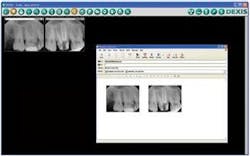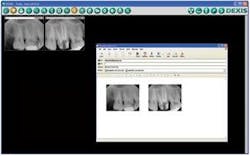Endodontics goes digital — getting to the root of the matter
by Lorin Berland, DDS
Few fields in dentistry require radiography more than endodontics. Whereas some specialties, such as cosmetic or restorative dentistry, are judged visually, the root canal treatment is determined and often judged radiographically. From preop to final fill, root canal therapy requires a minimum of three X-rays per tooth. Because of the importance of imaging, my endodontic colleagues have observed that digital radiography is probably their most utilized technology.
Endodontists need digital technology. A major factor is the number of X-rays required. Dentists should strive to protect the patient and minimize radiation exposure. Also, let’s face it, size matters — smaller is better. The sensors are smaller and more comfortable than traditional X-ray film. Images can be enhanced and magnified, resulting in much better clarity than reading that small piece of film. With digital, records can be shared between referring doctors instantly.
Prolonged treatment time is uncomfortable. No one likes to keep his or her mouth open unnecessarily with a rubber dam on. Film X-rays take too darn long. The endodontist cannot proceed to the next step of a root canal until the film is developed and read. So the patient waits for the preop, and then waits again with an open mouth and rubber dam in place, drowning in saliva, while the dentist waits again to judge the working length; then, still another X-ray is needed. That’s a lot of waiting, especially if a retake is needed. And you can be sure it seems a lot longer to the patient.
With digital, just click and the X-ray instantly appears on the screen; click again for the next one — and you can even take advantage of features like One-Tooth Series, where the software stands at-the-ready to take images without clicking anything! The doctor saves time, but the patient benefits the most. Add the advantage of a sensor such as DEXIS® with its rounded corners, and patients experience comfort as well as less chairtime.
Assistants also benefit from digital technology. With traditional radiographs, only the best assistants get a clear shot of the apex with a rubber dam in place. The assistant is not even aware a retake is needed until the film is developed, another five minutes. With digital, assistants can easily capture an accurate X-ray, even with the rubber dam in place. And with film, where is the assistant? In the darkroom, instead of with me or the patient!
Digital storage capabilities allow me to monitor changes over time. If I have been watching a suspicious lesion, I can park the older and most recent images on the screen side by side and even e-mail the images to specialists.
For example, when I recently sent a patient to an endodontist colleague, I was surprised when he recommended an extraction and an implant instead of endodontic treatment. When comparing the last year’s digital image taken at my office with the one that he took this year, he discovered resorption and a crack in the tooth. This was verified at the extraction visit. Root canal therapy wouldn’t have worked. Both of us would have looked bad and felt even worse to make the patient undergo root canal therapy, post and core or buildup, and a crown, just to have the tooth removed.
Endodontists with digital technology are focused on their patients’ safety and comfort. It’s too difficult to communicate and treat effectively without it. I will not work with an endodontist who does not own a digital system, but fortunately, every endodontist I know has already embraced digital technology as an integral part of his or her practice.
Dr. Lorin Berland is an internationally acclaimed cosmetic dentist and one of the most published authorities in the professional dental and general media. Dr. Berland, a Fellow of the American Academy of Cosmetic Dentistry, is the creator of the Lorin Library Smile Style Guide, www.denturewearers.com, and is the founder of Arts District Dentistry, a multi-doctor specialty practice in Dallas that pioneered the concept of spa dentistry.

